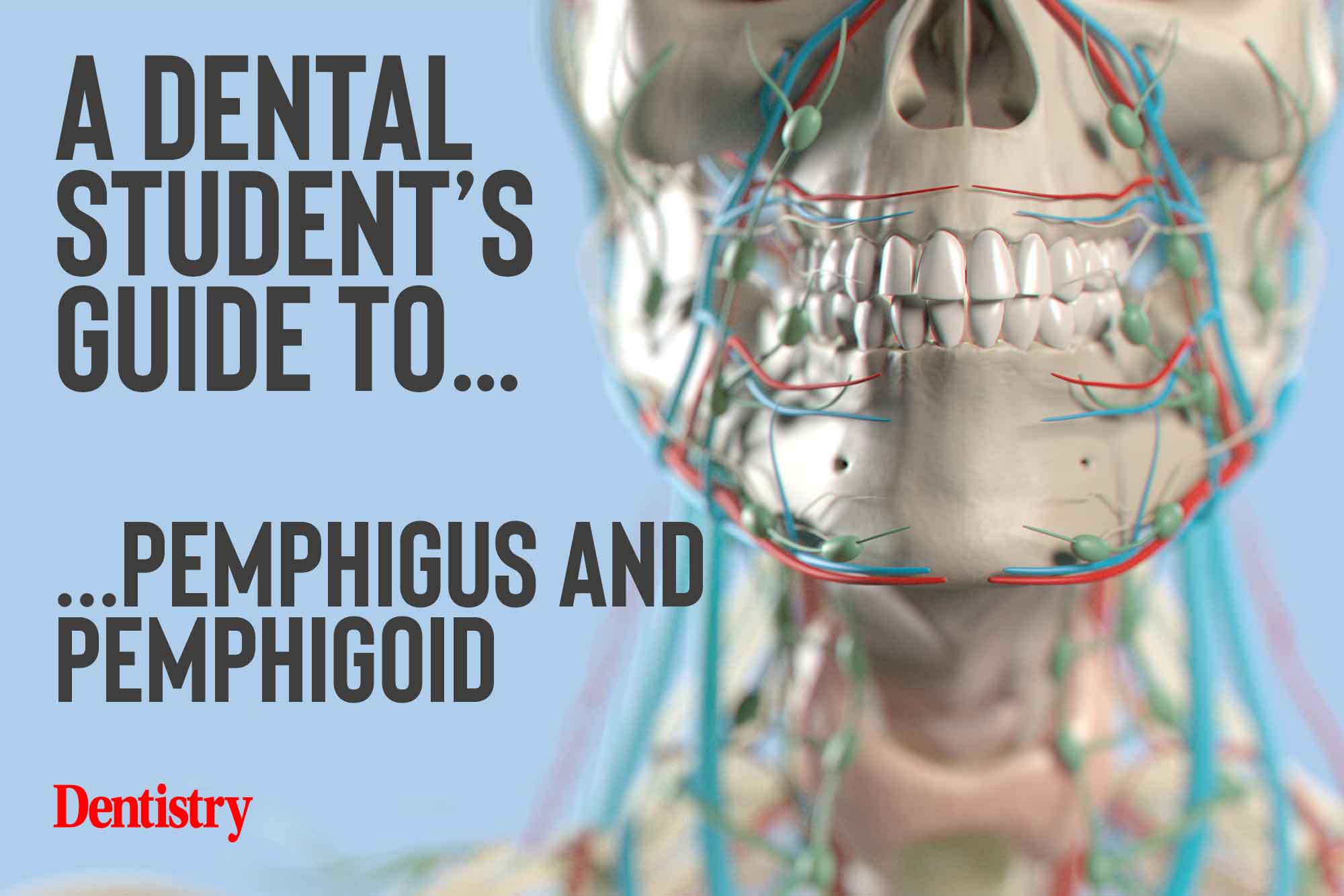 This month, Hannah Hook explores the autoimmune diseases pemphigus and pemphigoid and outlines how it manifests in the oral cavity.
This month, Hannah Hook explores the autoimmune diseases pemphigus and pemphigoid and outlines how it manifests in the oral cavity.
Pemphigus and pemphigoid are rare autoimmune diseases of the skin and mucous membranes. They result in the formation of blisters.
Both diseases are characterised by the presence of autoantibodies against antigens on keratinocytes.
Pemphigus affects the more superficial layers of the skin (epidermis). It leads to the formation of intraepithelial blisters that are easily ruptured.
In contrast, the deeper layers of the skin are affected in people with pemphigoid. It leads to sub-epidermal blistering.
Whilst involvement of other areas such as the throat, genitals, nose and eyes often occur, the oral cavity frequently displays the first manifestations of both diseases (Buonavoglia et al, 2019).
Pemphigus
Example: pemphigus vulgaris (PV)
Demographic: males and females affected equally, most commonly in adults age 40-60 years.
Signs and symptoms: more likely to affect the skin than pemphigoid. Blisters of the skin and mucous membranes that rupture easily and form painful erosions. Erosions on the skin may become infected and crusty. Erosions on mucous membranes may look raw. Sore eyes.
Oral manifestations: most commonly and often the first affected area. Gingivae rarely involved. Blisters that coalesce and burst to form erosions.
Mechanism: desmoglein is a type of cadherin that plays a role in the formation of desmosomes. Desmosomes enable cell-cell adhesion in the epidermis. Autoantibodies target desmoglein leading to damage of the desmosomes, which results in cell separation.
Features: nikolsky sign – the top layers of the mucosa come away when it is gently rubbed.
Treatment: usually requires systemic therapy.
Pemphigoid
Example: mucous membrane pemphigoid (MMP).
Demographic: women more affected than men. Most commonly in adults aged 60-80 years (Hong-hui et al, 2013).
Signs and symptoms: fragile blisters that rupture easily. Gritty eyes. Difficulty swallowing. Stuffy nose with blood stained mucous. Eye involvement does not occur in all patients with MMP but is potentially serious.
Oral manifestations: gingivae commonly involved, desquamative gingivitis leading to erythematous bands along gingival margin. Blisters that rupture to form erosions. Skin is less frequently involved compared to pemphigus.
Mechanism: hemidesmosomes enable the basal epithelial cells to adhere to the basement membrane. In patients with MMP autoantibodies target integrins and collagens, both of which are important in the formation of hemidesmosomes. This results in damage to the hemidesmosomes and separation of epithelial cells from the basement membrane.
Treatment: highly responsive to topical therapy (Sultan et al, 2017).
Diagnosis
Biopsy: a small piece of tissue from the blistered area goes to the lab for analysis by histology.
Direct immunofluorescence: the biopsy sample is treated to detect the presence of desmoglein auto antibodies.
Indirect immunofluorescence: blood serum is tested for the presence of desmoglein autoantibodies.
Topical treatment for oral lesions
Analgesia: numbing mouthwashes and sprays such as benzydamine (Difflam) can help reduce pain topically.
Topical steroids: direct application of the steroid to the affected area intra-orally may help reduce inflammation. Hydrocortisone oromucosal tablets, Beclomethasone dipropionate inhaler, Betamethasone soluble tablets (as a mouthwash).7 Bear in mind that steroids can lead to fungal infections.
Antibacterial: mouthwash such as chlorhexidine or hydrogen peroxide. Avoid mouthwashes that contain alcohol.
Systemic treatment
Oral corticosteroids: Initially high doses of corticosteroids such as prednisolone. This dose then gradually decreases as the condition comes under control.
Immunosuppressants: azathioprine, methotrexate and rituximab to suppress the autoimmune response.
Additional drugs: tetracyclines combines with nicotinamide or other types of antibiotics.
Other treatments: intravenous immunoglobulin therapy or plasmapheresis may be used if other treatments have not been effective.
Advice for patients (Sultan et al, 2017)
- Avoid foods that may irritate erosions eg spicy, acidic, salty
- Stop smoking
- Reduce alcohol intake
- Undergo regular check-ups with general dentist
- Maintain good oral hygiene
- Use an SLS-free toothpaste.
Key points
- Both pemphigoid and pemphigus are rare autoimmune conditions
- They both affect mucous membranes and can affect the skin
- They both require further treatment to help manage the conditions
- Pemphigus – superficial, severe, skin and sign (Nikolsky)
- Pemphigoid – deep.
Catch up with previous student’s guides:
Follow Dentistry.co.uk on Instagram to keep up with all the latest dental news and trends.
References
Buonavoglia A, (2019) Pemphigus and mucous membrane pemphigoid: An update from diagnosis to therapy. Autoimmun Rev 18(4); 349-58
Hong-hui X, Werth V, Parisi E and Sollecito T (2013) Mucous Membrane Pemphigoid. Dent Clin North Am 57(4); 611-630
Sultan A, (2017) Oral mucous membrane pemphigoid and pemphigus vulgaris – a retrospective two-centre cohort study. Oral Dis 23(4); 498-504

